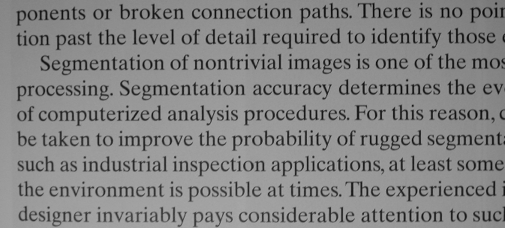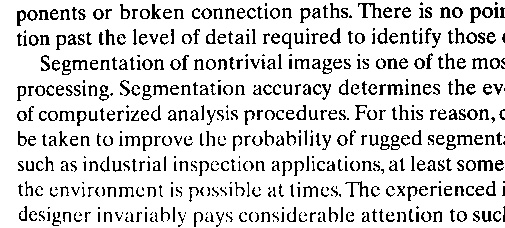1
2
3
4
5
6
7
8
9
10
11
12
13
14
15
16
17
18
19
20
21
22
23
24
25
26
27
28
29
30
31
32
33
34
35
36
37
38
39
40
41
42
43
44
45
46
47
48
49
50
51
52
53
54
55
56
57
58
59
60
61
62
63
64
65
66
67
68
69
70
71
72
73
74
75
76
77
78
79
80
81
82
83
84
85
86
87
88
89
90
91
92
93
94
95
96
97
98
99
100
101
102
103
104
105
106
107
108
109
110
| #include <opencv2/opencv.hpp>
using namespace cv;
void getHistogram(Mat &img, double *histogram){
int H[256] = {0};
for (int nrow = 0; nrow < img.rows; nrow++) {
for (int ncol = 0; ncol < img.cols; ncol++) {
int h = img.ptr<uchar>(nrow)[ncol];
H[h] ++;
}
}
int N = img.rows * img.cols;
for (int i = 0; i <= 255; i++) {
histogram[i] = double(H[i]) / double(N);
}
}
void Otsu(double *histogram, double &threshold){
double w1 = 0.0, w2 = 1.0;
double u1, u2;
double max = 0.0;
double sum = 0.0;
for (int i = 0; i <= 255; i++) {
sum += i * histogram[i];
}
double sum1 = 0.0, sum2 = sum;
double threshold1 = 0.0, threshold2 = 0.0;
for (int t = 1; t <= 255; t++) {
w1 += histogram[t];
w2 = 1 - w1;
if (w1 == 0) {
continue;
}else if (w2 == 0){
break;
}
sum1 += t * histogram[t];
sum2 = sum - sum1;
u1 = sum1 / w1;
u2 = sum2 / w2;
double v = w1 * w2 * (u1 - u2) * (u1 - u2);
if (v >= max) {
threshold1 = t;
if (v > max) {
threshold2 = t;
}
max = v;
}
}
threshold = (threshold1 + threshold2) / 2;
}
void getOtsuImg(Mat img, Mat &result, double threshold){
for (int nrow = 0; nrow <= img.rows; nrow++) {
for (int ncol = 0; ncol <= img.cols; ncol++) {
if (img.ptr<uchar>(nrow)[ncol] <= threshold) {
result.ptr<uchar>(nrow)[ncol] = 0;
}else{
result.ptr<uchar>(nrow)[ncol] = 255;
}
}
}
}
int main() {
Mat img,result;
img = imread("Otsu.png", IMREAD_GRAYSCALE);
if (img.empty()) {
printf("读取图像文件失败");
system("pause");
return -1;
}
double histogram[256] = {0};
getHistogram(img, histogram);
double threshold = 0;
Otsu(histogram, threshold);
result = img.clone();
getOtsuImg(img, result, threshold);
imshow("img", img);
imshow("Otsu", result);
waitKey();
imwrite("result.jpg", result);
return 0;
}
|










